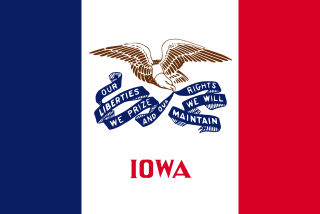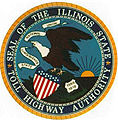
The coat of arms of the state of New York was formally adopted in 1778, and appears as a component of the state's flag and seal.

The flag of the state of Michigan is a coat of arms set on a dark blue field, as set forth by Michigan state law. The governor has a variant of the flag with a white field instead of blue one. The state has an official flag month from June 14 through July 14.

The flag of the state of Kansas was adopted in 1927. The elements of the state flag include the Kansas state seal and a sunflower. This original design was modified in 1961 to add the name of the state at the bottom of the flag.

The flags of the U.S. states, territories, and the District of Columbia exhibit a variety of regional influences and local histories, as well as different styles and design principles. Modern U.S. state flags date from the turn of the 20th century, when states considered distinctive symbols for the 1893 World's Columbian Exposition in Chicago, Illinois. Most U.S. state flags were designed and adopted between 1893 and World War I.

The flag of Colorado was officially adopted to represent the U.S. state of Colorado on June 5, 1911. The flag, designed by Andrew Carlisle Carson, consists of a fess design of three horizontal stripes of equal width, with the top and bottom stripes colored blue, and the middle stripe colored white. A circular red "C", filled with a golden disk, sits atop the stripes. All aspects of the flag contain symbolism related to the state, as the blue is meant to represent the sky, the gold the abundant sunshine the state receives, the white the snowcapped Rocky Mountains, and the red the "ruddy" earth. The gold and white portions of the flag also represent the state's gold and silver mining industries, respectively.

The flag of the state of Connecticut is a white baroque shield with three grapevines, each bearing three bunches of purple grapes on a field of royal blue. The banner below the shield reads "Qui Transtulit Sustinet", Latin for "He who transplanted sustains", Connecticut's state motto. The flag dimensions are 5.5 feet (1.7 m) in length and 4.33 feet (1.32 m) in width.

The flag of the state of Iowa is a vertical tricolor flag designed by Dixie Cornell Gebhardt in 1917. Iowa, United States legislators officially adopted the flag in 1921.

The flag of the state of Maine features Maine's state coat of arms on a blue field. In the center of the shield, a moose rests under a tall pine tree. A farmer and seaman represent the traditional reliance on agriculture and the sea by the state. The North Star represents the state motto: dirigo.

The flag of the state of Maryland is the 17th-century heraldic banner of arms of Cecil, 2nd Baron Baltimore. It consists of the arms of his father George, 1st Baron Baltimore (1579–1632), quartered with those of his grandmother, heiress of the Crossland family. The flag was officially adopted by the General Assembly of Maryland in 1904.

The Commonwealth of Massachusetts has been represented by official but limited-purpose flags since 1676, though until 1908 it had no state flag per se to represent its government. A variant of the white flag with blue seal was carried by each of the Massachusetts volunteer regiments during the American Civil War alongside the National Colors. An exception were the two "Irish regiments", each of which was permitted to carry an alternative green flag with a harp symbol.

The flag of Minnesota is the state flag of the U.S. state of Minnesota. Its design features a modified version of the seal of Minnesota emblazoned on a blue field. The flag's first version was adopted in 1893, in advance of the state's mounting an exhibition at the 1893 Chicago World's Fair. It was significantly revised in 1957 and received a minor update in 1983.

The flag of West Virginia is the official flag of the U.S. State of West Virginia and was officially adopted by the West Virginia Legislature on March 7, 1929. The present flag consists of a pure white field bordered by a blue stripe with the coat of arms of West Virginia in the center, wreathed by Rhododendron maximum and topped by an unfurled red ribbon reading, "State of West Virginia." It is the only state flag to bear crossing rifles, meant to illustrate the importance of the state's fight for liberty during the Civil War as the southern unionist 35th state.

The Great Seal of the State of Colorado is an adaptation of the territorial seal which was adopted by the First Territorial Assembly on November 6, 1861. The only changes made to the territorial seal design being the substitution of the words "State of Colorado" and the figures "1876" for the corresponding inscriptions on the territorial seal. The first General Assembly of the State of Colorado approved the adoption of the state seal on March 15, 1877. The Colorado Secretary of State alone is authorized to affix the Great Seal of Colorado to any document whatsoever.

The Great Seal of the State of Maine was adopted in June 1820. The concept of the design is attributed to Benjamin Vaughan of Hallowell, Maine, while the original sketch is credited to Bertha Smouse, the step-daughter of Col. Isaac Reed of Waldoboro, Maine, who purportedly wrote its official description and explanation. There have been variations in the details of the seal, but the overall design and images remain true to the original. The center of the seal is a shield adorned with a tranquil scene of a moose resting in a field bordered by water and woods; a pine tree stands tall directly behind the moose. On either side of the shield, a farmer rests on his scythe, and a sailor leans on an anchor. Above the shield is the motto "Dirigo" and a stylized North Star. Below the shield is a banner that reads "Maine". The legislature of 1919 decided that the design of the seal should no longer vary, and the design is still used today.

The seal of the Territory of Idaho was adopted in 1863 and redrawn several times before statehood in 1890. The first state Great Seal was designed in the 1890s by Emma Edwards Green, the only woman to design a U.S. state seal. That seal was used until 1957, when the seal was slightly redrawn by Paul B. Evans and the Caxton Printers, Ltd. at the request of the state government, in order to add more anthropocentric elements to the centered shield.

The Great Seal of Missouri is used to authenticate certain documents issued by the Government of Missouri. The phrase is used both for the physical seal itself, which is kept by the secretary of state, and more generally for the design impressed upon it. The Great Seal was designed by Robert Wells of Jefferson City.

The municipal flag of Cleveland serves as the representative banner of the city of Cleveland, Ohio, United States. The flag was designed by local art school graduate Susan Hepburn, and was officially adopted as the municipal banner by Cleveland City Council on October 21, 1895, with the ordinance on the flag adopted on February 24, 1896.

The Great Seal of the State of Minnesota is the state seal of the U.S. state of Minnesota. Originally adopted in 1858 following Minnesota's statehood, the seal's original version is an adaptation of Minnesota's territorial seal modified by the state's first governor and fur trader, Henry Hastings Sibley. It has been modified several times by the state legislature since 1858, including in 1971 and 1983. The seal's design symbolizes many important aspects to Minnesota's history and culture; such as the growth of industry powered by Saint Anthony Falls, the state's Native American heritage, the importance of industries like lumber and agriculture, and the taming of the wilderness by the state's early pioneers. The seal is prominently featured on the Minnesotan flag.
Sharon Tyndale was an American politician and designer who was the Secretary of State of Illinois, from 1865 to 1869. His tenure is notable for his redesign of the Great Seal of the State of Illinois.

The seal of Cincinnati is the official insignia of the city of Cincinnati, Ohio, in the United States. Adopted in 1819, the seal incorporates scales, a sword, and a caduceus. The seal is featured prominently in the flag of Cincinnati and the insignia of city agencies and institutions.































